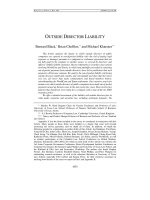Owner-Authorized HANDGUNS potx
Bạn đang xem bản rút gọn của tài liệu. Xem và tải ngay bản đầy đủ của tài liệu tại đây (738.15 KB, 68 trang )
Lance A. Davis and Greg Pearson, Editors
The National Academies Press
Washington, D.C.
www.nap.edu
Owner-Authorized
HANDGUNS
A Workshop Summary
THE NATIONAL ACADEMIES PRESS 500 Fifth Street, N.W. Washington, DC 20001
NOTICE: The project that is the subject of this report was approved by the Governing
Board of the National Research Council, whose members are drawn from the councils
of the National Academy of Sciences, the National Academy of Engineering, and the
Institute of Medicine. The members of the committee responsible for the report were
chosen for their special competences and with regard for appropriate balance.
Funding for the activity that led to this publication was provided by the National Acad-
emy of Engineering Fund.
International Standard Book Number 0-309-08975-1 (Book)
International Standard Book Number 0-309-52609-4 (PDF)
Additional copies of this report are available from the National Academies Press,
500 Fifth Street, N.W., Lockbox 285, Washington, DC 20055; (800) 624-6242 or
(202) 334-3313 (in the Washington metropolitan area); Internet, .
Copyright 2003 by the National Academy of Sciences. All rights reserved.
Printed in the United States of America
The National Academy of Sciences is a private, nonprofit, self-perpetuating society of distin-
guished scholars engaged in scientific and engineering research, dedicated to the furtherance of
science and technology and to their use for the general welfare. Upon the authority of the charter
granted to it by the Congress in 1863, the Academy has a mandate that requires it to advise the
federal government on scientific and technical matters. Dr. Bruce M. Alberts is president of the
National Academy of Sciences.
The National Academy of Engineering was established in 1964, under the charter of the Na-
tional Academy of Sciences, as a parallel organization of outstanding engineers. It is autonomous
in its administration and in the selection of its members, sharing with the National Academy of
Sciences the responsibility for advising the federal government. The National Academy of Engi-
neering also sponsors engineering programs aimed at meeting national needs, encourages educa-
tion and research, and recognizes the superior achievements of engineers. Dr. Wm. A. Wulf is
president of the National Academy of Engineering.
The Institute of Medicine was established in 1970 by the National Academy of Sciences to secure
the services of eminent members of appropriate professions in the examination of policy matters
pertaining to the health of the public. The Institute acts under the responsibility given to the
National Academy of Sciences by its congressional charter to be an adviser to the federal govern-
ment and, upon its own initiative, to identify issues of medical care, research, and education. Dr.
Harvey V. Fineberg is president of the Institute of Medicine.
The National Research Council was organized by the National Academy of Sciences in 1916 to
associate the broad community of science and technology with the Academy’s purposes of further-
ing knowledge and advising the federal government. Functioning in accordance with general poli-
cies determined by the Academy, the Council has become the principal operating agency of both
the National Academy of Sciences and the National Academy of Engineering in providing services
to the government, the public, and the scientific and engineering communities. The Council is
administered jointly by both Academies and the Institute of Medicine. Dr. Bruce M. Alberts and
Dr. Wm. A. Wulf are chair and vice chair, respectively, of the National Research Council.
www.national-academies.org
iv
STEERING COMMITTEE FOR NAE WORKSHOP ON
USER-AUTHORIZED HAND GUNS
LANCE DAVIS, Chair, National Academy of Engineering,
Washington, D.C.
MARK BEHRENS, ESQ., Shook, Hardy & Bacon, L.L.P.,
Washington, D.C.
PHILIP J. COOK, Duke University, Durham, North Carolina
T. DIXON DUDDERAR, Lucent Technologies (emeritus), Chatham,
New Jersey
CHARLES F. WELLFORD, University of Maryland, College Park,
Maryland
Project Staff
GREG PEARSON, Study Director and Program Officer, National
Academy of Engineering
RAYMOND A. NASH, JR., Consultant
ROBERT CHERRY, NAE Fellow, Idaho National Engineering and
Environmental Laboratory
CAROL R. ARENBERG, Editor, National Academy of Engineering
v
Preface
O
n June 2, 2002, the National Academy of Engineering (NAE)
convened a one-day workshop to consider issues related to the
development of owner-authorized handguns—firearms that
would operate only for an authorized user. Nearly 40 individuals represent-
ing diverse organizations and perspectives attended the session. The work-
shop explored the technical feasibility, legal implications, and possible soci-
etal consequences of handguns engineered to prevent or reduce
unintentional discharge or intentional, illegal use. The project was funded
by the NAE and is consistent with the Academy’s interest in topics that lie
at the intersection of technology and society. The planning of the work-
shop and the preparation of the summary report were substantially aided
by the volunteer services of the workshop steering committee. This report
summarizes the presentations of invited speakers and panelists.
Lance Davis
Steering Committee Chair and
Executive Officer
National Academy of Engineering
vii
Contents
Overview 1
Workshop Summary
Session 1: Technology for Owner-Authorized Handguns 9
Speaker Presentations, 9
Panel Presentations, 18
Session 2: Liability Concerns 25
Speaker Presentations, 25
Panel Presentations, 31
Session 3: Impact on Health and Crime 39
Speaker Presentations, 39
Panel Presentations, 44
References 52
Appendixes 53
A List of Participants, 53
B Workshop Agenda, 56
1
Overview
O
n June 2, 2002, the National Academy of Engineering (NAE)
convened a group of individuals in Washington, D.C., to discuss
owner-authorized handguns. Some 40 people with diverse back-
grounds took part in the one-day workshop (see Appendix A). This report
is a summary of the workshop discussions, which focused on three topics:
the state of the art of technology for creating owner-authorized handguns,
liability concerns affecting the development and use of such firearms, and
the potential impact of these devices on health and crime in the United
States (see Appendix B).
The National Academies, of which NAE is a part, are accustomed to
examining complex—sometimes controversial—issues at the intersection
of science, technology, and society. Owner-authorized handguns, often
called “smart” guns, have generated considerable public interest. The feasi-
bility and utility of smart firearms have been debated in a variety of
forums, but, for the most part, these discussions have not included the
engineering community.
The June workshop, funded by NAE, was intended to set the stage for
a more in-depth examination of owner-authorized handguns. In December
2002, NAE received support from the David and Lucile Packard Founda-
tion to assess the technical feasibility of developing a reliable smart hand-
gun. The 12-month project, which began in summer 2003, will provide
2 OWNER-AUTHORIZED HANDGUNS
cost and time estimates for bringing one or more smart-gun technologies to
the marketplace.
For the purposes of the June 2002 workshop, an “owner-authorized
handgun” was defined as a firearm that would only function when operated
by the designated owner of the handgun. In retrospect, a better descriptor
might have been “user-authorized,” since there are situations in which a
person other than the handgun owner might have a legitimate need to fire
the weapon. For example, more than one adult in a family might need
access to a handgun for purposes of home-defense; and in some police
departments, law enforcement personnel share firearms.
Whatever the terminology, owner-authorized handguns are meant to
prevent specific unintended or undesirable uses of handguns: accidental
shootings, usually by very young children; the shooting of police officers by
assailants using the officers’ own weapons; suicides, especially by teenagers;
homicides by individuals using stolen handguns, guns purchased informally
(“gray market” firearms), or guns sold illegally (“black market” firearms);
and other crimes, including robberies, committed with stolen handguns or
guns purchased on the gray or black market.
Simple methods of preventing guns from firing, such as grip safeties,
have been available for a century or more. Although the focus of the work-
shop was on high-tech approaches to preventing unauthorized use, the ap-
plication of certain low-tech solutions, such as trigger locks, could be an
effective deterrent in some situations. More sophisticated technologies have
only recently begun to be investigated. These include systems with elec-
tronic, magnetic, mechanical, radio, and sensor components, often in com-
bination. Access may be controlled based on something the gun owner
knows (e.g., a PIN code), something the owner possesses (e.g., a magnetic
ring), or something unique to the owner (e.g., a fingerprint).
As is true of technologies generally, whatever technology is contem-
plated for owner-authorized handguns will be imperfect. Every technology
has advantages and drawbacks and creates new, unanticipated problems.
No single technological approach is likely to satisfy the needs of all handgun
users. Police officers, for example, have different requirements for handguns
than typical homeowners trying to protect their families. By the same token,
the needs of these two groups differ from those of gun collectors and target
shooters. All users, however, appear to have a common interest in technology-
enhanced firearms that are as reliable and robust as traditional handguns.
No hard data are available about the amount of money being spent on
research and development (R&D) related to smart-handgun technologies.
OVERVIEW 3
R&D by the gun industry is probably limited, however. For several years,
the federal government has supported a small amount of R&D on smart
handguns through a program at the National Institute of Justice. And at
least one state, New Jersey, has earmarked funds for smart-handgun re-
search at a state-run university. Taken together, these investments appear to
fall well short of the amount necessary to bring a technology to the com-
mercial marketplace in the near future.
Product liability will influence both the ability and the willingness of
gun makers to pursue the development of owner-authorized handguns.
Guns differ fundamentally from other products in that, in normal use, they
are intended to cause harm. Therefore, liability is limited to foreseeable,
“unintended” injuries caused by a defect in the firearm. Defects may result
from manufacturing flaws, design flaws, or a failure to provide adequate
warning of the risks of using the product.
The existence of a defect is based on the state of the art at the time the
product was manufactured. The challenge for the courts will be to deter-
mine the state of the art at a given point in time. If a technology for owner-
authorized handguns matures and is considered state of the art, it is pos-
sible that a gun manufacturer could be held liable for not incorporating it.
In such a climate, the threat of litigation could provide a strong incentive
for R&D and innovation. Gun makers who pursue smart-handgun tech-
nology might realize a competitive advantage over those who do not. Gun
makers who lag behind could risk being shut out of the marketplace.
Given the technical challenges of producing a reliable owner-authorized
firearm, however, the fear of litigation could also stifle innovation. Gun
makers have three not-mutually-exclusive avenues for addressing the liabil-
ity threat: creating the best design and warning possible; buying liability
insurance; or seeking protection from the government. Legislation now
working its way through Congress would prohibit civil liability actions
against gun manufacturers for damages resulting from the misuse of their
products. The bill provides no protection to gun makers for injuries caused
by defective products, however.
Every year, handguns kill and injure thousands of people and are used
in the commission of a variety of crimes. Policy makers at the state and
national levels, and the public, have focused on police officer gun takeaways
and accidental shootings involving children as the problems that can be
best addressed by owner-authorized handgun technology. However, these
two problems account for a small percentage of the deaths and injuries
caused by handguns. According to the FBI, between 1992 and 2001,
4 OWNER-AUTHORIZED HANDGUNS
46 police officers were killed by service revolvers—either their own or a
partner’s—in the hands of an adversary (FBI, 2001).
Fewer than 200 chil-
dren under age 20 were killed by unintentional discharges of firearms in
2000, the latest year for which there are data (NCHS, 2002).
In contrast,
of the 28,663 individuals killed by firearms in 2000, 58 percent (16,586)
were suicides, and 38 percent (10,801) were murder victims.
Although most crimes are not committed with guns, the majority of
gun crimes are committed with handguns. According to the National Crime
Victimization Survey, perpetrators of nearly 90 percent of rapes and sexual
assaults, robberies, and aggravated assaults in 1993 used handguns in
committing their crimes (Zawitz, 1995). Slightly more than half of the
roughly 500,000 guns stolen each year are handguns. A variety of studies
have shown that adult and juvenile offenders have stolen firearms or kept,
sold, or traded stolen firearms.
Smart-handgun technology could influence the diversion of firearms
from authorized to unauthorized users. Diversion occurs through transfers
within the home; seizures of handguns from victims by assailants; thefts
from homes, vehicles, and commercial locations; and transfers in so-called
secondary markets, such as “straw” purchases made on behalf of individuals
who cannot legally buy guns. Smart-handgun technology could make un-
authorized transfers difficult or unprofitable. Because there are some
70 million “dumb” handguns in circulation in the United States, the im-
pact of technology-enhanced firearms on suicide and homicide rates would
depend on their speed of market penetration. The ultimate size of the effect
would be influenced by the interplay of a variety of legal, behavioral, eco-
nomic, and other factors.
The availability of owner-authorized handguns could encourage some
people to purchase firearms who otherwise might not, thus increasing the
total number of handguns in circulation. The availability of firearms per-
ceived to be “safe” could also have the unintended effect of encouraging
people to use less stringent firearms storage practices. And because it might
be difficult to tell the difference visually between a technology-enhanced
handgun and a dumb handgun, the presence of smart handguns—in the
home, for example—could increase the risk of accidental discharges of
weapons mistaken for smart handguns.
Given the uncertainties involved and the absence of data, it is
impossible at this time to predict whether reliable owner-authorized hand-
guns would have an overall beneficial or detrimental effect, especially in the
short term. Despite this uncertainty and the current technical immaturity
OVERVIEW 5
of these devices, the potential utility of owner-authorized handguns is
intriguing. Considerably more research—in the laboratory and by social
scientists—will be necessary to provide manufacturers, policy makers, and
the public with enough information to make informed decisions on this
important topic.
Workshop Summary
9
Session 1
Technology for
Owner-Authorized Handguns
Speaker Presentations
D
r. Lance Davis, executive officer of the National Academy of En-
gineering (NAE), opened the Workshop on Owner-Authorized
Handguns with some welcoming comments. He explained that
NAE’s mission is to promote the technological welfare of the nation by
marshalling the talents of eminent members of the engineering profession
to study issues at the intersection of technology and society, such as the
focus of this workshop, owner-authorized handguns. The people attending
the workshop, who are involved in the social, legal, or political aspects of
gun safety, are well aware that a so-called smart handgun could have an
impact on crime and public health and that several technology-related ques-
tions are central to the issue. How mature is the technology for owner-
authorized weapons? How reliable will these guns be? How long would it
take to put them into production? What would it cost?
Dr. Davis noted that the complex issues surrounding smart handguns
could not be addressed in a single day and the workshop would probably
not provide definitive answers to those questions. The workshop would
help NAE frame a future study of the state of research and technology for
smart guns.
FIRST KEYNOTE SPEAKER
The first of the two keynote speakers, Don Sebastian of the New
Jersey Institute of Technology (NJIT), has been involved with the issue of
10 OWNER-AUTHORIZED HANDGUNS
smart-gun technology for about three years, since the New Jersey Senate
began considering legislation to mandate the development of smart-gun
technology. (The legislation was enacted in December 2002.) In 2001,
NJIT received a $1 million appropriation from the New Jersey legislature
to study smart-gun technology in 1999. The legislature appropriated an
additional $500,000 in both 2000 and 2002 to supplement the first award.
The legislature mandated that the study focus on smart guns that could
address the issue of child safety in the home (legislators used the terms
“child-safe” guns, “owner-only” guns, and “smart” guns interchangeably).
The legislators wanted to address three concerns: accidental shootings, de-
liberate crimes by children, and teen suicides. Dr. Sebastian said that NJIT
willingly pursued the study under those terms—not for the money but
because the institution has always been willing to tackle difficult public-
policy questions. Such work, he said, is part of the institution’s responsibil-
ity as a technological research university.
With the appropriation, the NJIT study focused on three critical ques-
tions: Does smart-gun technology exist? If it doesn’t but is possible, what
would be needed to bring it to the commercial marketplace? Finally, what
can NJIT do to bring smart guns closer to market?
One of the first discoveries the NJIT researchers made, Dr. Sebastian
said, was that “smart gun” is a term of art. People talked about smart guns
as if one existed; there was not an engineering definition of it much less an
actual product. The researchers also observed that most people believe that
the technologies to create a smart gun already exist. It was, people thought,
just a matter of desire for all of the pieces to be put together. The team also
learned that a single smart-gun design was not likely to solve all handgun
safety problems.
As background for the NJIT study, the team looked into a study (Weiss,
1996) conducted by Sandia National Laboratories in 1995 with funding
from the National Institute of Justice (NIJ). That study had focused on the
problem of law-enforcement “take-away”—when a police officer’s gun is
taken away during a crime. The New Jersey legislature, in contrast, was
concerned with guns owned by private individuals. Whereas police weapons
must be protected from an array of potential abusers, household weapons
must be protected most of all from family members. The NJIT researchers
concluded that a typical gun owner could not be depended on to adhere to
rigorous standards of gun safety. Owners often do not use locking devices
or maintain the integrity of the ones they do use. As an example,
Dr. Sebastian cited some extant devices that depend on a personal
SESSION 1: TECHNOLOGY FOR OWNER-AUTHORIZED HANDGUNS 11
identification number. The research team found that the codes became
common knowledge in a family, and that most codes could be easily
discovered by hackers. In short, private gun owners need a technological
solution that performs well despite neglect and abuse. Police officers need a
technology that will guard against illegal transfer and perform well while
the owner maintains strict, rigorous procedures.
Gun hobbyists and sports enthusiasts have entirely different needs,
according to Dr. Sebastian. The main concern of these gun users is very
likely accidental discharge. Some firms are already working on smart-gun
technologies to deal with that issue.
The NJIT researchers developed a list of requirements for home-owner
handguns. When not in use, the gun would have to be in a protected mode
yet be ready to fire. The gun would have to be able to identify its rightful
owner without time-consuming, cross-modal actions.
People often assume that a single technology will solve all of these
problems. Popular expectations tend to focus on technology based on fin-
gerprints or voice recognition. Dr. Sebastian emphasized, however, that
solving all of these problems will require a systems approach. A gun that
turns on when it recognizes a legitimate user will have to be based on a
system that integrates several technologies.
During the study, NJIT worked with the New Jersey-based Joint Ser-
vices of the Small Arms Program (JSSAP), which designs sidearms for the
armed services. JSSAP tested 18 commercially available lock-on, bolt-on
handgun safety devices and concluded that all of the products manufac-
tured for home use could be compromised with relative ease. In fact, they
concluded, none was any better than a traditional lock box.
NIJ is also funding research on electronic analogues of a lock and key.
Designed for law enforcement, most of these technologies require a device
worn on the person, such as a ring or watch, that communicates with the
gun by radio frequency (RF) or ultrasonics. In a home environment, how-
ever, the “key” component of these systems is likely to be stored near the
gun or in an easily discovered hiding place. And so these technologies,
although important from a research standpoint, are not well suited to
home use.
To create a true smart gun, according to Dr. Sebastian, it will be
necessary to develop a system that uses an attribute of the user or owner—
a biometric—as a nontransferable token, a key that cannot be counter-
feited or shared. Moreover, of the technologies that might be used in smart
guns, biometrics seems to be the most mature. Biometrics are being
12 OWNER-AUTHORIZED HANDGUNS
investigated for an array of other uses and, therefore, already have a fairly
diverse market demand.
NJIT researchers studied commercially available fingerprint identifica-
tion devices in the laboratory. Although these devices have not been
embedded in guns, they are already in common use, typically to provide
computer-related security. The team studied four fingerprint-recognition
technologies—one that used optical scanning, two that used capacitative
measurements, and one that used infrared. The hardware was tested with
commercially available software and with a more sophisticated pattern-
recognition software developed by BES, a New Jersey company. They also
tested BioMouse, an accessory for a computer mouse used in the log-in
process in e-commerce to verify purchaser identity. But Biomouse, the size
of a traditional optical scanner, cannot be miniaturized to fit inside a gun.
The mechanical failure rate of traditional handguns is around 1 in
20,000. With fingerprint devices failure rates were at best 1 in 100; at
times, the failure rate was as high as 1 in 4. The best result with these
devices was a 99 percent recognition rate, and that rate could only be
achieved under pristine laboratory conditions, with the sensor stringently
cleaned between every use. And that rate is about two orders of magnitude
higher than the mechanical failure rate. Trying to capture a fingerprint
with a fixed sensor, the researchers concluded, would be difficult in real-
world situations. In addition, there was no apparent technological growth
path for any of the sensor technologies that would bring the failure rate
down to the ideal rate. This does not mean that fingerprint technology
should be discarded, but it does suggest fingerprint technology might be
more effective if it were integrated into a multisensory approach to user
identification.
The NJIT team next looked into using the way each person grabs a
gun handle to differentiate among gun users. The researchers captured hand
placements and sizes from several hundred people to see if they could be
used to identify individuals. Hand size was fairly reliable they found,
although reproducibility was better for practiced handgun users, such as
law-enforcement professionals, than for non-users. When the researchers
added sensors to the grip that measured grip pressure during the period of
trigger squeeze, the trace of the grip over time could be used to differentiate
among hundreds of different users. Satisfactory results were achieved with
as few as nine pressure sensors. The NJIT laboratory is now experimenting
with micropatterning inside the hand grip of the guns used by the New
Jersey State Police.
SESSION 1: TECHNOLOGY FOR OWNER-AUTHORIZED HANDGUNS 13
Dr. Sebastian said he foresees a system approach based on multiple
modalities. If one technology has a 1 in 100 failure rate, and another has its
own 1 in 100 failure rate, when they are used together, they would have a 1 in
10,000 failure rate. That rate would approach the rate of mechanical failure.
Dr. Sebastian noted that many people think gun manufacturers should
be able to develop a reliable smart gun using their own R&D capacity. He
estimated that total annual revenues for the gun industry are about $500
million and a reasonable investment in research of 1 percent—or $5 mil-
lion per year—would not be enough to bring a smart handgun to the mar-
ketplace. In fact, he said, neither public entities nor private firms will be
able to create smart guns on their own. Gun manufacturers do not have the
necessary expertise in software development and microsensor technologies.
Public entities simply do not have enough funding to carry out the research
on their own. Some sort of public-private partnership will be necessary.
NJIT is now working on a small project with the Picatinny Arsenal to
evaluate hand-grip technology in live-fire situations using advanced simu-
lation environments. NJIT has also submitted a proposal to NIJ to create
grip-dynamic technology and validate it in live-fire situations. But this is an
enormous undertaking, and as the technology gets closer to real-world test-
ing, the costs of development will increase exponentially.
Training a weapon to recognize its authorized user is a real concern. At
present, NJIT has developed a grip template that uses 30 “trigger” points to
recognize the user—10 points as a baseline and the remaining 20 to estab-
lish its robustness. One important question that has arisen is whether a
user’s profile changes in stressful situations. Handguns in private hands
present different problems. If a gun comes with a simple home-use kit—if
the process is very open—children might be able to reprogram the gun
themselves. Would that invalidate the authorization? Different states already
have different policies regarding handgun safety, and states may also demand
that they be allowed to train and validate weapons in their own ways.
Dr. Sebastian said there is an acute need for solid, platform-
independent, technology-independent standards for legislation regarding
smart guns. The standards must be appropriate for the application environ-
ment and must specify the levels of recognition and reliability a smart gun
would be expected to provide. Only such neutral, objective rules would
provide technology developers with standards for judging the suitability of
a particular technology or system.
Eventually nontechnology issues, such as product liability, will also
have to be addressed. Dr. Sebastian emphasized that even though gun
14 OWNER-AUTHORIZED HANDGUNS
manufacturers are working on the problem of smart guns, unless the matter
of liability is resolved, smart guns will never reach the marketplace. An-
other important issue is the question of proprietary rights. If smart guns are
developed through public-private partnerships, who will produce the new
weapons? Who will have the right to distribute them and to train people to
use them? When smart guns are ready for sale, who will administer and
authenticate the technology?
Moreover, the entire issue of deployment and enforcement could stray
into the sensitive area of gun control. These problems will have to be ad-
dressed early on, before they become explosive and expensive to address.
SECOND KEYNOTE SPEAKER
John Wirsbinski of Sandia National Laboratories, the next keynote
speaker, talked about a very different user group for smart guns: law-
enforcement personnel. In 1994, he said, NIJ asked Sandia to take a sys-
tems engineering look at the problem of law-enforcement officers being
killed in the line of duty when their own weapons were used against them.
Sandia’s 1996 report was based on that review. More recently, NIJ asked
Sandia to take another look at the gun take-away issue to determine how
the technology has evolved (Wirsbinski, 2001). Both reports were driven
by an assessment of user requirements and focused on systems engineering.
The first report used a key analogy: a key, a lock, and a discriminator. In the
second report, keys and discriminators were examined from the perspective
of access control.
The term smart gun has become such a catchall phrase that the Sandia
researchers felt it essential to establish categories to distinguish the types of
smart-gun technology. Just as there are several ways to get into a building,
there are several possible ways to limit access to a gun. The first way is with
mechanical safeties. These are not really smart-gun technologies because
they cannot keep a gun from being used by anyone who knows how to
operate the mechanical device. However, Mr. Wirsbinski said that he had
heard of at least two cases in which a mechanical device on a police officer’s
gun had delayed an adversary from firing long enough for the officer to
regain control of the weapon. Some types of mechanical devices are not
very helpful, however. Trigger safeties, for instance, cannot prevent the de-
liberate firing of the weapon by an unauthorized user—with the safety off,
the gun will discharge no matter who pulls the trigger. Mechanical thumb
safeties, however, could delay adversaries for a brief period.
SESSION 1: TECHNOLOGY FOR OWNER-AUTHORIZED HANDGUNS 15
Another type of access device is a gun lock. Gun locks are commer-
cially available now, both as retrofits and integrated in new firearms. Many
are token based, requiring a key. One problem is that the keys tend to be
universal, so anybody could have one. But the mere act of locking a gun
does provide some security, although it probably would not be very useful
in a law-enforcement scenario. It would be hard to imagine a police officer
carrying around a locked weapon, and having to get out a key to use it.
Police officers could use gun locks when it was necessary to relinquish a
gun, if it had to be stored for a period of time, for instance.
Most current technology development is focused on self-locking weap-
ons that revert to a secured state when they are released from a firing grip.
Right now there is a great deal of discussion about technologies to realize
such weapons, such as magnetic rings and biometric approaches, including
grip scans and fingerprint readers. One company is experimenting with
thermal scans of subcutaneous structures. In a law-enforcement scenario,
the latter approach could pose problems. For instance, wearing gloves might
affect the scan. Another company is producing a fingerprint reader that
uses sound waves that can actually penetrate gloves, which might resolve
some of the problems associated with fingerprint scans.
The ideal solution for law enforcement is a truly personalized weapon,
which will almost certainly be an evolution of a self-locking weapon. But a
self-locking weapon, by definition, can only offer a partial solution because
it cannot satisfy all of the requirements established in Sandia’s 1996 report.
But no self-locking weapon is available now; and none will be available in
the near future. Producing such a weapon will require systems integration,
which is always a troublesome engineering problem. In addition, miniatur-
ization issues will have to be addressed.
Most likely, the solution will emerge from one of two technologies:
biometrics or a system using an RF transmitter. One promising type of RF
transmitter would be a weapon activated by a chip embedded in the user’s
hand. Mr. Wirsbinski told the audience that when he first heard this tech-
nology proposed as an answer for a self-locking weapon, he did not take the
idea seriously. But such chips are already being used in other fields. They
are surprisingly popular in health care, for example, where they are used to
embed vital medical information that patients always carry with them.
Embedded chips have also been used for quite some time to identify pure-
bred animals. Using this technology for a user-authorized weapon would
require a small coil inside the gun to generate an induction field with
enough power to retrieve information from a chip embedded in the
16 OWNER-AUTHORIZED HANDGUNS
authorized user’s hand. The embedded chip concept would resolve a
number of problems with locking technology, such as the possibility of
losing a magnetic ring. Mr. Wirsbinski said he has been approached by a
gun manufacturer in a country whose military was interested in developing
such a weapon for its special forces. In the United States, Mr. Wirsbinski
said, developing such a technology for use by police would introduce
troublesome privacy issues.
Before biometric user-authorized weapons become common, Mr.
Wirsbinski said, many hurdles will have to be overcome, including user
acceptance. A few years back, he said, he had worked at an Air Force facility
that had just put in place a huge new access-control system that included
retinal scans, card swipes, and pin codes. Soon after the system was imple-
mented, a general came through and flatly refused to submit to the retinal
scan. He said, “You are not scanning my eyeball with a laser; I don’t trust
it.” The retinal scan was turned off. Another serious issue in the law-
enforcement community is reliability. It will be essential that any new tech-
nology be proved as reliable in everyday use as the technology the police
have now.
Another very complex issue is training handguns to recognize their
authorized users. Access control is based on the idea that there is a central
location where the access-control database is stored. It is analogous to using
a badge reader to get into a building. When you swipe the card, data on the
card are compared to data in the computer database, a relatively simple
matter. But with a biometric weapon, things would be more complicated.
Ideally, the weapon itself would carry the database. When the weapon is in
enrollment mode, it would build a template of the authorized user. Then,
when it is in use, it could recognize the user, either by comparing his or her
template to all of the templates in the database and looking for a match or
by directing the system to compare the biometric reading to the specific
template of the user to confirm his or her identity. But for a handgun to
carry the entire database of stored templates, enormous technical challenges
would have to be overcome.
Another potential problem in training a biometric weapon is that a
user who is properly enrolled onto a biometric weapon may not be recog-
nized because the template can be thrown off by user stress. When the body
goes into fight-or-flight mode, many things change, such as blood flow,
muscle tension, and even physical structures. At these times, things that
were learned in an unstressed situation become inaccessible. How can bio-
metric gun technology cope with this reality?









